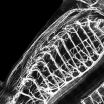A better way to treat HIV-infected children?
Switching from protease inhibitors to Nevirapine brings superior results for some HIV-Infected children
2010-09-08
(Press-News.org) September 7, 2010 (4 pm ET) – Nevirapine is widely used to help prevent mother-to-child transmission of the HIV virus. In cases where the infants are nonetheless infected with HIV virus at birth, the standard treatment is to use protease inhibitors (PI) to reduce the amount of virus in their bloodstream. A new study involving 195 infants in South Africa found that children who were treated with PI and then switched to nevirapine were more likely to maintain virus below the detection threshold of the test than infants who continued to receive PI. Results of the study are available in the September 8 issue of JAMA.
Nevirapine has the additional advantage of being less costly than PI—an important benefit particularly in the under-resourced nations of sub-Saharan Africa. Moving away from PI-based regimens could offer other advantages as well: the unpleasant taste of protease inhibitors makes it more difficult for parents to ensure that children receive their medications every day, and there are concerns about metabolic toxicities with long-term use during critical periods of child development.
"Our results suggest that a majority of nevirapine-exposed children who are successfully treated with protease inhibitors could benefit from being switched to nevirapine. The switch regime is easier for the child and his or her parents to adhere to and would also save money," says senior author Louise Kuhn, PhD, professor of epidemiology at Columbia University's Mailman School of Public Health and the Gertrude H. Sergievsky Center, Columbia College of Physicians and Surgeons.
The trial was conducted between April 2005 and May 2009 at a hospital in Johannesburg. All 195 participating children had received the standard PI therapy of ritonavir-boosted lopinavir, stavudine, and lamivudine and had achieved viral suppression of less than 400 copies/mL for 3 or more months. A control group of 99 children continued to receive this therapy, while 96 others were switched to nevirapine. Children were followed up for 52 weeks after randomization.
Researchers found that children switched to nevirapine were more likely to maintain virus below the detection threshold of the test than infants who continued to receive PI. Children in the control group were more likely to have virus levels of 50 copies/mL or higher (58%) than children in the switch group (44%). However, children in the switch group were more likely to develop a high viral load of 1,000 copies/mL—a result associated with poor adherence to the drug regimen or drug-resistance before treatment.
While evidence suggests that switching children to nevirapine is generally a good strategy following successful treatment with PI, the researchers emphasized this should only be done with adequate monitoring of virus levels. "Although the value of virologic monitoring in HIV treatment is strongly emphasized in well-resourced settings, most programs in low-resource settings do not include it as part of routine services because of cost. Simple algorithms could be developed for targeted virologic testing to safely implement the switch strategy," the authors conclude.
INFORMATION:
(JAMA. 2010;304[10]:1082-1090. Available pre-embargo to the media at www.jamamedia.org)
About the Mailman School of Public Health
The only accredited school of public health in New York City and among the first in the nation, Columbia University's Mailman School of Public Health pursues an agenda of research, education, and service to address the critical and complex public health issues affecting millions of people locally and globally. The Mailman School is the recipient of some of the largest government and private grants in Columbia University's history. Its more than 1000 graduate students pursue master's and doctoral degrees, and the School's 300 multi-disciplinary faculty members work in more than 100 countries around the world, addressing such issues as infectious and chronic diseases, health promotion and disease prevention, environmental health, maternal and child health, health over the life course, health policy, and public health preparedness. www.mailman.columbia.edu
END
ELSE PRESS RELEASES FROM THIS DATE:
2010-09-08
Chemists at the University of California, San Diego, have identified how a protein that accumulates in the brains of people with Alzheimer's disease interferes with the ability of cells to get rid of debris. They also found a natural mechanism by which this protein, amyloid beta, itself may be discarded.
Plaques of amyloid are a hallmark of the ailment, but no one is sure exactly how they contribute to catastrophic loss of memory and cognition.
Scientists have begun to suspect that amyloid disables a structure called a proteasome, which chops up proteins that cells ...
2010-09-08
Too much testosterone can be a deal breaker, according to Sauder School of Business researchers at the University of British Columbia. Their paper, to be published in the INFORMS journal Management Science on September 10, shows that young CEOs with more of the steroidal hormone in their system are more likely to initiate, scrap or resist mergers and acquisitions.
The study by Sauder Finance Professors Maurice Levi and Kai Li, and PhD student Feng Zhang, titled "Deal or No Deal: Hormones and the Mergers and Acquisitions Game," shows that testosterone – a hormone associated ...
2010-09-08
Fairbanks, Alaska—A University of Alaska Fairbanks fisheries scientist has teamed up with Alaska Power and Telephone to study how a new power-generating turbine affects fish in the Yukon River.
So far, the news looks good for the fish.
"In the brief testing that we have been able to accomplish, we have no indication that the turbine has killed or even injured any fish," said Andrew Seitz, project leader and assistant professor of fisheries.
Alaska Power and Telephone installed the in-stream turbine near Eagle, Alaska this summer. They are testing its effectiveness ...
2010-09-08
CHAMPAIGN, Ill. – There's a reason why some sports fans are referred to as "die-hards" – even after they move away, their loyalty to their hometown team endures, according to research by two University of Illinois professors.
Scott Tainsky and Monika Stodolska, professors of recreation, sport and tourism, say new residents of a community maintain an attachment to their old team or former city as a way of asserting their identity after they move.
"People new to a city don't just adopt their new hometown's team as a way to acclimate themselves in a new community," Tainsky ...
2010-09-08
CHAMPAIGN, Ill. — A University of Illinois economist says consumers and investors concerned about the specter of deflation looming over an already bleak economic landscape should relax – for the time being, at least.
Although the consumer price index is near zero, J. Fred Giertz says we're unlikely to see a prolonged deflationary period like the slump Japan experienced during its "lost decade" of the 1990s.
"We're close to zero right now, but we're not below zero," said Giertz, an Institute of Government and Public Affairs economist who compiles a monthly barometer ...
2010-09-08
PROVIDENCE, R.I. [Brown University] — Most proteins are shapely. But about one-third of them lack a definitive form, at least that scientists can readily observe. These intrinsically disordered proteins (IDPs) perform a host of important biological functions, from muscle contraction to other neuronal actions. Yet despite their importance, "We don't know much about them," said Wolfgang Peti, associate professor of medical science and chemistry. "No one really worried about them."
Now, Peti, joined by researchers at the University of Toronto and at Brookhaven National Laboratory ...
2010-09-08
A new study identifies molecules that can be used to selectively reduce generation of the sticky, neuron-damaging plaques that are the hallmark of the Alzheimer's disease (AD) brain. The research, published by Cell Press in the September 9 issue of the journal Neuron, may lead to the development of effective and safe therapeutics for this currently incurable disease.
Previous research has suggested that an alteration in brain levels of amyloid ? proteins (A?) plays a major pathogenic role in AD, a devastating neurodegenerative disorder that causes progressive cognitive ...
2010-09-08
Addictive drugs are known to induce changes in the brain's reward circuits that may underlie drug craving and relapse after long periods of abstinence. Now, new research, published by Cell Press in the September 9 issue of the journal Neuron, uncovers a specific neural mechanism that may be linked to persistent drug-seeking behavior and could help to guide strategies for development of new therapies for cocaine addiction.
Previous research has shown that the ventral tegmental area (VTA) is a brain region that is activated when cocaine users experience a craving for cocaine ...
2010-09-08
New York (September 8, 2010) – In a surprising and unexpected discovery, scientists at NYU Langone Medical Center have found that a single type of gene acts as a master organizer of motor neurons in the spinal cord. The finding, published in the September 9, 2010 issue of Neuron, could help scientists develop new treatments for diseases such as Lou Gehrig's disease or spinal cord injury.
The "master organizer" is a member of the Hox family of genes, best known for controlling the overall pattern of body development. By orchestrating a cascade of gene expression in ...
2010-09-08
A team of scientists, led by University of California, San Diego School of Medicine researchers, has synthesized hundreds of new compounds with the potential of reducing the production of the A-beta 42 peptide, a primary component of Alzheimer's disease (AD).
In mouse models, one tested compound specifically reduced levels of A-beta 42, which is believed to be responsible for the destruction of neurons, but left other essential enzymatic activities in the brain unaffected, said Steven Wagner, PhD, a project scientist in the UCSD Department of Neurosciences.
The ...
LAST 30 PRESS RELEASES:
[Press-News.org] A better way to treat HIV-infected children?
Switching from protease inhibitors to Nevirapine brings superior results for some HIV-Infected children




